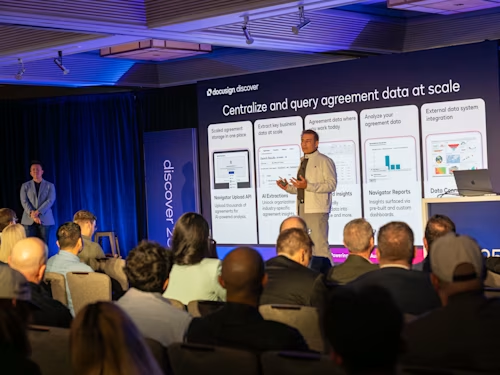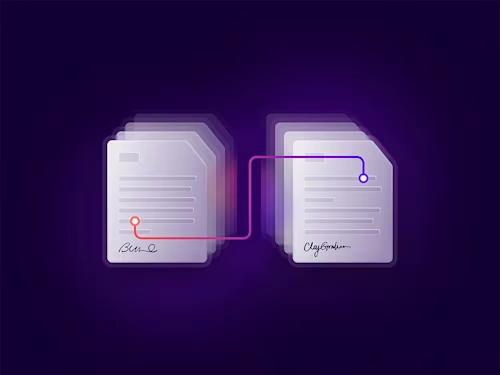
Seamlessly integrating Maestro with data systems using data IO extensions
Streamline agreement management with Docusign's data IO extensions. Seamlessly integrate systems such as Salesforce and Dynamics with Docusign Maestro for faster, automated workflows that save time and eliminate errors.

Last year, Docusign announced our Intelligent Agreement Management (IAM) vision to address Agreement Trap problems. These problems are costly and common, from critical agreement data being trapped in static documents to disconnected products requiring manual and error-prone interactions when moving resources from one system to another. With IAM, customers can create, commit, manage, and automate agreements—streamlining how products interconnect and unlocking meaningful agreement data across systems. We are making it simple to automate end-to-end processes such as detecting an agreement expiration, triggering a renewal workflow, prepopulating the agreement with data from an external system, getting the agreement signed, and archiving it for further analysis and management.
A critical component of enabling this IAM vision is Docusign for Developers, which we launched at our inaugural Discover event in 2024. Docusign for Developers introduced new experiences to help developers get started, build, and manage their Docusign projects, making it easier and faster for developers to bring Docusign into their products (APIs) and their products into Docusign (extensions).
Within Docusign, we have a team that uses Docusign for Developers to create integrations with ubiquitous systems-of-record products such as customer relationship management (CRM) systems. Recently, we launched two of those integrations, for Salesforce and Microsoft Dynamics 365, built with Docusign for Developers. Below, I’ll outline the platform features our team used so you can learn how to interconnect your public or private data systems with Docusign Maestro to address your enterprise needs, solve cross-product integration problems for your customers, or promote your services.
Learn more Read our blog, Seamless CRM Integration: Salesforce and Dynamics 365 Extension Apps for Maestro, to learn more about how our new Salesforce and Dynamics integrations can help your business intelligently manage sales agreements.
Unlocking the agreement trap with Docusign extensions
First, why should you care about integrating your data systems with Docusign? According to a 2024 study by Deloitte, Unlocking the Value of Agreement Management, disconnected workflows—causing an 18% increase in time spent on agreements or, globally, 55 billion hours wasted every year—are at the root of poor agreement management. The more Docusign and its partners intelligently and scalably interconnect our products, the faster and cheaper our shared customers can come to agreement. We also know that manual data entry is a top pain point. Indeed, the same study found that 54% of respondents manually enter data across systems. Instead, they want out-of-the-box integrations that enable them, with little setup, to automate data movement processes.

Launched in Q4 2024, Docusign for Developers now supports extensions that map to cross-product integration use cases. These extensions are packaged in extension apps and published to the new Docusign App Center for easy discovery, installation, connection, and management. They can then be deployed across many agreement scenarios in products like Maestro, enabling no-code process builders to leverage the underlying interconnectivity over and again.
Learn more Take a look at our extensions glossary and FAQs to familiarize yourself with common terminology and questions. Then dive into 101 topics such as the differences between extension apps and API integrations, extension app use cases, how extension apps work, supported extensions, and how to build an extension app.
Automating data flows with data IO extensions
As a Docusign developer, whether you’re a systems integrator (SI), independent software vendor (ISV), or corporate developer, leveraging the data IO extension will enable your customers to bring their data stored in your systems into and out of Docusign agreement flows. This extension addresses two primary use cases: data input and data output, which can be used individually or together. All extensions are composed of actions that map to external product platform endpoints that Docusign experiences will call when interacted with by customers.
When implementing a data input extension that will read information from your systems into Maestro, you need to implement three actions: GetTypeNames, GetTypeDefinitions, and SearchRecords. The first two actions use the public API endpoints of the 3P system to pull in and store the required Concerto-standard data models when an authentication connection is created. The last action is called as a Maestro workflow instance executes a query configured by the workflow builder against the 3P system.

The data input (read) configuration experience in Maestro for the Salesforce extension app
A data output extension is used to create or update the data in your system using data available in Maestro, such as workflow variables. To create this extension, you’ll need to support five actions: GetTypeNames, GetTypeDefinitions, SearchRecords, CreateRecord, and PatchRecord. As mentioned, the first two actions pull in required data models. In this use case, CreateRecord is called if the process builder chooses to create a new record in the 3P system of record; SearchRecords and PatchRecord are called if the process builder chooses to find an existing record to update it.

The data output (write) configuration experience in Maestro for the Salesforce extension app
For each of these use cases, as process builders and participants interact with the workflow experiences, there’s a flow of data from Maestro to our Developer Platform, and then out to the 3P system and back. To understand that flow better, read the data IO extension overview, specifically the Get type names and definitions, Input data, and Output data sections.
When the data flows out of Docusign to your 3P system, it does so via webhooks that invoke API endpoints in the extension app back end. Typically, the back-end IT infrastructure is composed of an API proxy that can transform the output from Docusign into a format natively understood by the 3P system and vice versa; authorization systems to enable Docusign to securely connect; and, if required, network configuration to allow Docusign to communicate with your product. Together, these capabilities enable Docusign and 3P systems to integrate reliably and maintain the trust of our customers.
To help you get started more quickly with all of the concepts above, you can view and clone the data IO reference implementation available on GitHub. This reference covers choosing local vs. cloud hosting; generating secrets; installing dependencies; setting up a proxy server for local development; the scaffolding code for API proxy endpoints for the data IO extension; and creating, testing, and publishing an extension app.

Data IO reference implementation on GitHub
When you’re ready, you publish an app using the Docusign Developer Console and your developer account. Once your app is reviewed and published, Docusign admins can discover, learn about, install, connect to, and manage your data IO extension app in one central place within the App Center. As the publisher, you can use the Developer Console extension app dashboard to monitor key metric trends such as the number of accounts that have installed or uninstalled your app, filtering by such criteria as configurable time periods and demo or production environments. As we evolve this experience, you will be further empowered to ensure you’re providing a great, reliable, value-add experience to users of your app.
Learn more When publishing and distributing your extension app, you can choose to make it public or private and specify the geographic regions in which to deploy it. If you're considering private visibility, check out our private extension apps overview to learn about the benefits, use cases and how to get started.
Start building data IO extensions today
This post was a whirlwind tour of extensions, and specifically the data IO extension powering our new Salesforce and Dynamics extension apps. We covered required actions (API endpoints) for data input and output use cases; how Docusign Maestro experiences and your 3P system interact when customers are inputting and outputting data; how to build an extension app; and getting it published through the Developer Console into the App Center for your customers to use.
Whether you’re building for Salesforce, ServiceNow, Airtable, or another system, data IO extensions give you the tools to create seamless, real-time agreement workflows that eliminate manual work and keep your data systems in sync. For another real-world example, check out this recent article at The New Stack detailing how our partners at Sandbox Banking are transforming financial workflows with the Glyue data IO extension app.
“By automating workflows such as updating customer profiles or managing agreements, we significantly reduce manual processes and improve operational efficiency.” -Thomas Ngoy, Solutions Architect at Sandbox Banking
We’re excited to see what you build next!
Sign up for a free developer account to get started.
Check out our data IO reference implementation.
Join the Docusign Developer Community to connect with other developers and get support.

Brendyn Alexander is Lead Product Manager for Build Developer Experiences with the Docusign Developer Experience team. He and his team create the tools and APIs for integrating Docusign into third-party products and third-party products into Docusign. He's been with the company since April 2023.
Related posts
Docusign IAM is the agreement platform your business needs





